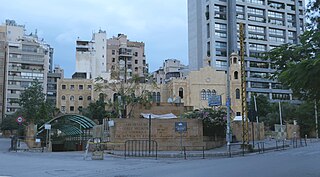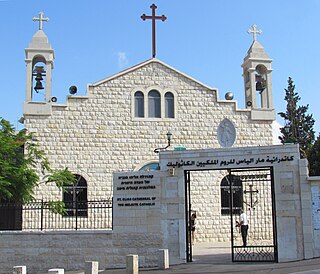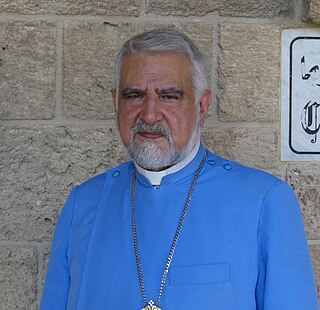
The Melkite Greek Catholic Church or Melkite Byzantine Catholic Church, is an Eastern Catholic church in full communion with the Holy See as part of the worldwide Catholic Church. Its chief pastor is Patriarch Youssef Absi, headquartered at the Cathedral of Our Lady of the Dormition, Damascus, Syria. The Melkites, Byzantine Rite Catholics, trace their history to the early Christians of Antioch, formerly part of Syria and now in Turkey, of the 1st century AD, where Christianity was introduced by Saint Peter.
Melkite Greek Catholic Archeparchy of Zahle and Forzol is a diocese of the Melkite Greek Catholic Church.

The Archeparchy of Beirut and Byblos is a metropolitan eparchy of the Melkite Greek Catholic Church since 1881, an Eastern Catholic church in communion with the Roman Catholic Church. Located in Lebanon, it includes the cities of Beirut and Byblos, and in terms of population, it is the largest Melkite eparchy in the Middle East. Its current Eparch, Georges Wadih Bacouni, S.M.S.P., was elected in November 2018.

Melkite Greek Catholic Archeparchy of Akka is an Eastern Catholic diocese of Melkite Greek Catholic Church, directly subject to the Melkite Patriarch of Antioch. Its Cathedral episcopal see is St. Elijah Greek-Melkite Cathedral, in Haifa.
The Apostolic Vicariate of Beirut is a Latin Rite missionary pre-diocesan exempt jurisdiction of the Catholic Church in Lebanon, where otherwise Eastern Catholics are far more numerous. In 2010, there were 15,000 baptized. Its current bishop is Cesar Essayan.

Georges Bacouni, also transliterated Bakhouni or Bakouny, is the appointed Archbishop of the Melkite Greek Catholic Archeparchy of Beirut and Byblos
Melkite Greek Catholic Archeparchy of Baniyas is a diocese of the Melkite Greek Catholic Church suffragan of the Melkite Greek Catholic Archeparchy of Tyre. In 2009 there were 2,500 baptized. It is currently governed by Archeparch Georges Nicholas Haddad, SMSP. The Archeparchy is named after the city of Baniyas.

Michel Abrass, BA is a retired church official who was Archbishop of the Melkite Greek Catholic Archeparchy of Tyre from 2014 to 2021.
Georges Haddad was Archbishop of the Melkite Greek Catholic Archeparchy of Tyre in Lebanon.
Melkite Greek Catholic Archeparchy of Tripoli(in Latin: Archeparchy Tripolitana Graecorum Melkitarum) is a diocese of the Melkite Greek Catholic Church suffragan of the Melkite Greek Catholic Archeparchy of Tyre. It is governed by Archeparch Eduard Daher, BC.
Melkite Greek Catholic Archeparchy of Sidon is a diocese of the Melkite Greek Catholic Church suffragan of the Melkite Greek Catholic Archeparchy of Tyre. In 2010 there were 32,000 baptized. It is currently governed by Archeparch Elie Bechara Haddad, BS.
Basile Khoury, BS was the first Archeparch of the Melkite Greek Catholic Archeparchy of Sidon in Lebanon.
Michel Hakim, BS was Vicar Apostolic of Canada and first bishop of the Melkite Greek Catholic Eparchy of Saint-Sauveur in Montréal in Canada.
Elie Bechara Haddad, BS is a Lebanese prelate of the Melkite Greek Catholic Church who has been the Archeparch of the Melkite Greek Catholic Archeparchy of Sidon since 2007.
Melkite Greek Catholic Archeparchy of Homs is a nominally Metropolitan Archeparchy of the Melkite Greek Catholic Church in central Syria. It was established on March 4, 1849 and has no suffragan, but two merged-in eparchial titles.
Saint Elias Greek Catholic Cathedral is a Melkite Greek Catholic cathedral located in downtown Beirut, Lebanon, dedicated to Saint Elias, completely restored after the Lebanese Civil War (1975–1990) on previous constructions dating to a Choueirite convent from the 19th century. Its plan followed the Byzantine style.

The St. Elijah Cathedral also called St. Elias Greek-Melkite Cathedral, is the name given to the Melkite cathedral in Haifa, serving the Greek-Catholics of the Byzantine rite making up the majority of Christians in both Haifa and Israel. St. Elijah Cathedral is the cathedral of the Melkite Greek Catholic Archeparchy of Akka, which was created by bull Episcopalis synodus of Pope Paul VI.

Charbel Yusef Abdallah is the Archeparch of the Maronite Catholic Archeparchy of Tyre.



































